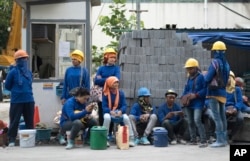Migrant workers from the Asia-Pacific region sent $256 billion home last year, but more needs to be done to cut costs and make money transfers easier, said a United Nations report Monday.
Remittances, which have risen about 5 percent since 2008, helped about 320 million family members across the region last year, according to the United Nations' International Fund for Agricultural Development (IFAD).
"It is crucial and critical to make sure these flows arrive fast and cheap," said Pedro de Vasconcelos, a remittance expert at the IFAD. "It is a lifeline for millions of families."
According to the report, 80 million migrant workers sent money home an average eight to 10 times per year.
They usually paid about 7 percent in charges to use cash-to-cash transfers, which enable money to be sent overseas often without using a personal bank account.
A decade ago, remittances to people in rural areas could cost as much as 20 to 25 percent in fees, charges and currency exchange rates, said De Vasconcelos.
But rates are still too high despite increased competition, he added.
He urged those making and receiving remittances to embrace digital technology such as mobile phones for transferring money, and he predicted that such methods would soon overtake cash-to-cash.
Regulators and the private sector must also work together to harmonize the legal and regulatory frameworks between countries and support new technologies that enter the market, he added.
"The process of sending this money is where the real opportunity exists," De Vasconcelos said.
Asia-Pacific is the biggest destination for remittances worldwide, with migrants holding jobs overseas that include construction, domestic work and health care, according to IFAD.
About 70 percent of remittances to the Asia-Pacific region came from Gulf countries, the United States and Europe.
"The type of work varies but you definitely see a majority of middle- to low-skilled labor," De Vasconcelos said.
The three largest remittance-receiving nations were India at $69 billion, China at $64 billion and the Philippines at $33 billion, according to the report.
Remittances contributed an average 60 percent to a receiving household's income, and the total was more than 10 times the amount of development aid received in the Asia-Pacific region.
About 70 percent of remittances are spent on basic needs like food, clothes, health care and education for families that are mostly in rural areas, according to the report.
The remaining 30 percent, or $77 billion, is often saved and invested in income-generating activities or investments, IFAD said.







